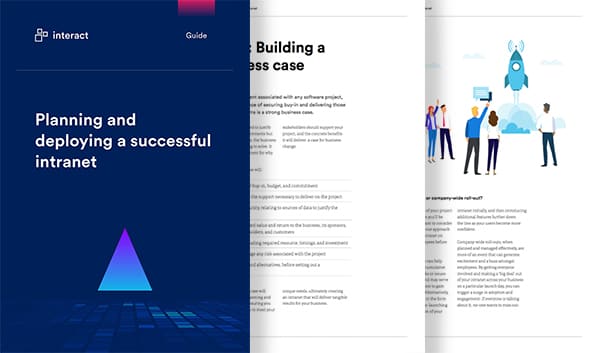We all know external branding is important, but what about internal branding? Internal branding helps connect your employees with your brand and company values. When implemented correctly, it can drive engagement and improve business outcomes. In this post, we’ll show you how to build your internal branding strategy in five steps.
In a saturated market that requires key differentiators to stand apart from competitors, engaging and aligning employees to the company brand may be the single greatest priority to ensure business success.
Yet despite its indisputable value, many organizations have yet to extend the same investment into their internal branding as they do into their external branding.
Free guide: Essential internal communications strategy
Employees form ‘touchpoints’ for engagement with customers, consumers, and potential ‘reviewers’ in a multitude of ways within their roles, whether that be your shop clerk processing a customer transaction or your HR manager interviewing your next would-be employee. If those employees aren’t invested in your brand or engaged with your business, something as small as a throwaway comment or a lack of feedback could cause long-term damage to your organization.
Success in business is all about people, people, people. Whatever industry a company is in, its employees are its biggest competitive advantage. As Virgin Pulse CEO Chris Boyce said recently, they’re the ones making the magic happen—so long as their needs are being met.
– Sir Richard Branson, Founder, Virgin Group
To build a strong and successful brand, your organization requires an inside-out approach that begins with embedding high levels of engagement in your employees. That’s where internal branding comes in.
What is an internal branding strategy?

Branding is a strategic way to showcase an organization through image, messaging, and values. Good branding strategy helps a company better attract customers and differentiate itself from competitors. Branding strives to boost perceived levels of credibility, quality, and satisfaction in the eyes of the customer.
But what does that mean to employees?
Internal branding is a corporate philosophy that focuses on bringing the company’s core culture, identity and premise to its employees in addition to its customers. It typically aims to make workers at all levels “ambassadors” or true representatives of the company and its values.
So how can I demonstrate the value to my senior leadership team?
If you’re excited by the prospect of implementing an internal branding strategy but you’re unsure how to convince senior leadership, you should look towards the impact it can have on the bottom line.
For example, employee engagement, productivity, and customer satisfaction are three specific areas where strong internal branding helps to bolster the bottom line. Here’s how it can contribute to each of these areas:
Increased employee engagement:
- Aligns employees with company values and goals
- Fosters a positive work culture
- Creates clear communication and recognition
- Reduces turnover and boosts performance
Improved productivity:
- Empowers and motivates employees
- Enhances skills and improves processes
- Satisfied, engaged employees are more productive
Increased customer satisfaction:
- Provides a consistent customer or end-user experience
- Empathetic employees lead to better customer interactions
- Encourages innovation and customer-centric solutions
- Satisfied customers refer others and remain loyal, boosting revenue
Put simply, by investing in your internal brand and ensuring that employees understand and live by it, you can create a positive ripple effect that extends to your organization’s external brand and supports financial performance.
Free guide: Essential internal communications strategy
How to build your internal branding strategy
So how do you go about creating and embedding an internal brand that will transform employees into true brand ambassadors who contribute to the success of your business?
These five steps will show you how:
1. Define your values and mission

Without a defined direction, your business will lack an identity or purpose with which your employees can identify. Defining your organization’s mission, vision, values, and culture and emphasizing those philosophies or principles that make you, “YOU” will communicate to your employees exactly what is important. Companies whose employees have a higher sense of purpose outperform others by as much as 400%.
Having a strong mission and values gives your employees a sense of purpose in their roles, increasing job satisfaction and promoting engagement—which has a proven link to business outcomes.
An internal branding win
Professional services giant KPMG, taught us all a lesson in internal branding when it launched a ‘Purpose Program,’ asking employees to respond to the prompt “what my job means to me.”
As a result, the company was overwhelmed by an astounding 42,000 entries via its employee intranet, with staff creating posters that included personal testimonials relaying the meaning they derived from their jobs. From “I advance science” to “I help farms grow,” the responses demonstrated the company values and purposes that resonated with employees. After this initiative, the company went on to have the most profitable year in its 118-year history.
Want to create values to engage your workforce, but unsure where to start? Our post on 7 steps for defining & writing a company vision statement outlines a process for defining and rolling out your own sense of purpose.
2. Engage your People

Your internal brand is centered around your people, defined by your people, and driven by your people. So get them involved.
Start by getting feedback from your employees. Figure out how they perceive your brand and get their input in defining and shaping it. Using employee surveys, focus groups, open discussion forums, and Q&A sessions, you can provide employees with a sense of ownership that will increase engagement and receptiveness to the concept. Get ideas from your employees—listening to their thoughts on how your brand could be more engaging could generate out-of-the box ideas and create more buy-in.
Consider assigning dedicated people to internal change communication and internal branding, picking out those engaged employees who are well-positioned to become ‘brand ambassadors’ for the company. Employees are more likely to buy into positivity about their organization from their peers than top-down, from management. That’s because, presumably, individuals are championing the brand because they believe in it—not because they have to.
3. Give your internal brand a strong identity—and align it with your external one

Your external brand is (hopefully) already defined; it will have its own logo, font, colors, tone of voice, messaging, and more. Your internal brand should have the same. A memorable identity will help your internal brand stick and translate that identity and meaning into your employees’ everyday lives.
It’s essential that your internal brand aligns with your external one. This connectivity helps employees understand how the two relate and ensures integrity. If your company is putting out one message to its consumers (e.g., “our number one priority is customer service”) and a very different one to its employees (e.g., “our number one priority is to be the biggest provider in the market by volume of customers”), this mismatch will cause confusion and disillusionment with your company’s purpose and direction. Drawing on the same ‘big ideas’ promoted in external branding not only resonates better with employees, but can also result in more distinctive and authentic external marketing.
However, putting unique spin on your internal brand will ensure its distinct and give employees a sense of ownership. For example, take your existing logo and assign a spin-off color or name for internal communications purposes, or create a new, different intranet name or brand that’s associated with your external brand.
Free guide: Essential internal communications strategy
4. Communicate and embed your internal brand strategy

After you put some time into your internal branding, you’ve probably defined your purpose in the form of your mission, vision, and values, you have input into how employees perceive your brand, and you’ve created logos, messaging, tone, and design to help it stand out. Now, it’s time to communicate your internal brand to its intended audience: your employees.
Creating an emotional connection between employees and your brand is not something that can be achieved via an all-company memo or a poster on your bulletin board. To ensure that your internal brand informs the way your employees approach their roles and engage with your organization, you need to initiate a proper strategy that communicates the internal brand clearly and impactfully.
Use a multi-pronged approach to introduce and explain your new internal brand. Then, reinforce it by applying that branding to every internal touchpoint. Consider running launch workshops, a launch party, or a town hall announcement. Design a staggered communication plan so no one can miss it, and ensure more detailed information is easily accessible via your intranet software.
Consider your staff’s day-to-day activities and weave your internal brand into the fabric of those experiences—try including your internal brand statement and values on your intranet homepage, internal email signatures, in-office posters, or the login screens for HR or finance tools. Remember that this process is about inspiring, motivating and persuading your employees, not simply informing; so be creative and encourage two-way conversations by providing platforms for feedback and discussion.
Finally, your internal brand should be something people talk about. Make it easy to define and communicate—think short, snappy, and memorable phrases or taglines, rather than a ten-page PDF of ‘brand guidelines and principles’. This is the key to ensuring it resonates with your employees.
5. Recognize, reward, and incentivize

One common failure of internal branding initiatives is a lapse in focus and motivation after the initial launch. To truly drive a successful internal branding strategy that transforms employee engagement, your brand needs continual reinforcement. This should come from both upper management and from everyday employees.
Have an employee, or several, who have demonstrated a true ‘living-the-brand’ approach to their work? Recognize their efforts and shout about it. Use internal communication channels and your employee intranet to share stories and demonstrate how your brand translates into the day-to-day roles of your company’s people.
Go one step further and set incentives or competitions to truly embed your internal brand’s principles and drive performance. At Interact, our peer-to-peer recognition program includes the use of #hashtagging our business values when nominating colleagues for employee recognition. When employees are rewarded for embodying brand values, it reminds the whole company about why we do what we do, and provides a sense of purpose.
When it comes to creating brand ambassadors through rewards, remember that money alone is often insufficient. People think more frequently about non-cash, tangible incentives (such as merchandise and travel) than cash incentives and as the frequency of thought increases, performance increases.
Measuring the success of your internal brand strategy
Measuring the effectiveness of an internal branding strategy is essential to ensure that your efforts are making a positive impact on your organization. So how exactly do you go about that?
From employee surveys to social media engagement and intranet analytics, there are various measurement methods you can use. Here are some specific metrics and tips to help you gauge the success of your internal branding strategy:
Employee surveys:
Conduct regular company culture surveys to gauge employees’ perceptions of the company’s brand, culture, and values. Include questions related to brand alignment, employee understanding of the brand, and how well they can articulate the company’s mission and values.
Employee advocacy:
Measure employee advocacy by tracking the number of employees who actively promote the brand on social media platforms such as LinkedIn and Instagram. Engagement metrics within the platforms can reveal increases in likes, shares, comments, and follows related to your brand-related posts.
Intranet analytics:
Use intranet analytics to check for increased engagement with brand-related content. Track page views, time spent, and click-through rates for brand-focused articles, videos, or resources.
Training and development metrics:
Measure the participation and completion rates of brand-related training and development programs. This can include e-learning modules, workshops, or onboarding programs.
Brand recognition and recall:
Test employee brand recognition and recall through quizzes or surveys and assess their ability to accurately describe the brand’s values, mission, and vision.
Employee feedback:
Encourage open feedback from employees through channels like suggestion boxes, feedback forms, or focus groups. Collect qualitative insights on the cultural impact of internal branding and how it affects colleagues’ daily work and engagement.
Recruitment and retention:
Happy employees are more likely to stay with the company, so track recruitment success and employee retention rates to see if a strong internal brand positively influences talent acquisition and retention.
Behavioral changes:
Look for observable behavioral changes among employees that align with your branding goals such as increased collaboration, adherence to company values, or more positive attitudes.
Employee stories and testimonials:
Anecdotal evidence can serve as qualitative confirmation of your branding success. Collect employee stories and testimonials that highlight their positive experiences with the brand and its impact on their work, and showcase them on your intranet homepage and in your employee email newsletter.
Cost savings:
As we highlighted earlier in this article, a strong internal brand can lead to financial benefits, so it pays to measure any cost savings related to branding, such as reduced turnover, lower recruitment costs, or increased productivity.
Benchmarking:
Compare your internal branding metrics to industry benchmarks or to previous periods to gauge progress and identify areas for improvement.
Alignment with external brand metrics:
It may help to assess how well your internal branding aligns with external brand metrics, such as customer perception and market reputation. A strong internal brand should positively influence these external metrics and prove the worth of your efforts.
Measuring the success of internal branding is an ongoing process, and it’s important to regularly review and adjust your strategy based on the data and feedback you gather. By using a combination of quantitative and qualitative metrics, you can get a holistic view of your internal branding’s impact to help guide your next steps.
A rewarding investment
Building and embedding an internal brand strategy takes time and investment. However, the rewards are extensive. Engaged employee brand ambassadors contribute to tangible returns for your business, including:
- Advocacy: 78% of engaged employees would recommend their company’s products and services.
- Retention: Highly engaged organizations can reduce staff turnover by as much as 87%.
- Customer service: 70% of engaged employees say they have a good understanding of how to meet customer needs.
- Revenue and return: During a study, companies with highly engaged employees improved operating income by 19.2% over a 12 month period.
There are many more benefits. The question shouldn’t be whether you can afford to invest in your internal brand—it should be, can you afford not to?


